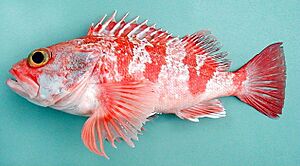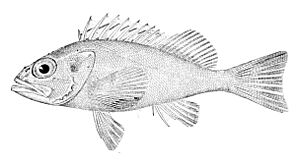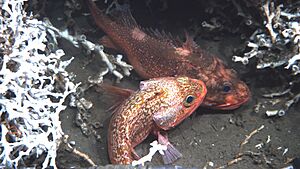Helicolenus dactylopterus facts for kids
Quick facts for kids Helicolenus dactylopterus |
|
|---|---|
 |
|
 |
|
| Conservation status | |
| Scientific classification | |
| Synonyms | |
|
The blackbelly rosefish (also called bluemouth rockfish or bluemouth seaperch) is a type of ray-finned fish that lives in the ocean. It belongs to a group of fish called scorpionfish. This fish is a "sit-and-wait" hunter, meaning it waits for its prey. It also has special colors that help it blend in with its surroundings, which is called cryptic coloration.
Contents
What's in a Name?
The blackbelly rosefish was first officially described in 1809. A scientist named François-Étienne de La Roche gave it the name Scorpaena dactyloptera.
Later, in 1896, two other scientists created a new group of fish called Helicolenus. They decided that the blackbelly rosefish would be the main example for this new group.
The name dactylopterus comes from two Greek words. Dactylos means "finger," and pterus means "finned." This name refers to the lower parts of the fish's pectoral fins, which have long, thin tips that look a bit like fingers.
Where Do They Live?
The blackbelly rosefish lives in many parts of the Atlantic Ocean. In the western Atlantic, you can find them from Nova Scotia in Canada all the way down to Venezuela.
In the eastern Atlantic, they live from Iceland and Norway down to South Africa. They are also found around islands like the Azores, Madeira, and Canary Islands. You can also find them throughout the entire Mediterranean Sea.
How Do They Live?
The blackbelly rosefish is a type of scorpionfish that lives near the bottom of the ocean. They prefer soft, muddy areas on the continental shelf and the upper slope.
These fish have been found at depths from about 50 to 1,100 meters (164 to 3,609 feet). However, they usually live between 150 and 600 meters (492 to 1,969 feet) deep.
What Do They Eat?
Blackbelly rosefish eat both creatures that live on the ocean floor (benthic) and those that swim in the open water (pelagic). Their diet includes:
- Crabs and shrimp (decapod crustaceans)
- Other fishes
- Cephalopods like squid and octopuses
- Sometimes, they also eat pyrosomes (small sea creatures), polychaetes (bristle worms), and echinoderms (like sea stars).
The types of food they eat can change depending on how big the fish is.
What Do They Look Like?
The blackbelly rosefish is a strong, sturdy fish with a large head. It has small, brush-like teeth on both its upper and lower jaws. Its large mouth is dark inside.
Size and Age
Male blackbelly rosefish tend to grow longer and heavier than females of the same age.
- Longest recorded: 47.0 centimeters (about 18.5 inches)
- Common length: 25.0 centimeters (about 9.8 inches)
- Heaviest recorded: 1,550 grams (about 3.4 pounds)
- Oldest reported age: 43 years
Body Features
This fish has several fins:
- The dorsal fin (on its back) usually has 12 stiff spines and 11–13 soft rays.
- The anal fin (on its underside) has 3 spines and 5 rays.
- The pectoral fins (on its sides) have 17 to 20 rays.
Their bodies are covered in small, rough scales arranged in 55 to 80 vertical rows. The chest, cheeks, and upper jaw area usually have scales. However, the snout and the bottom part of the head are smooth. They typically have 25 vertebrae (backbones).
Color
The color of the blackbelly rosefish can vary. Their back and sides are usually red, and their belly is pink. They often have 5 to 6 dark bands on their body:
- Below the front, middle, and back parts of the dorsal fin spines.
- Below the soft part of the dorsal fin.
- At the base of the caudal fin (tail fin).
- There's also a Y-shaped dark bar between the soft dorsal fin and the anal fin.
- Often, a dark spot can be seen on the back part of the spiny dorsal fin.
Venom
Like other types of scorpionfish, the spines of the blackbelly rosefish contain a mild venom. If a person accidentally gets poked by these spines, it can cause some pain. However, there hasn't been much research done on the specific venom from this fish.
Reproduction
Blackbelly rosefish have a unique way of reproducing. The eggs are fertilized inside the female's body. Males produce sperm from July to early December, with the most sperm found from September to November.
After fertilization, it takes about 1 to 3 months for the eggs to start developing. The female can store sperm inside her body. This allows her to produce multiple groups of embryos, which are covered in a jelly-like substance. The young fish start as tiny larvae that float in the open water, and then they grow into juveniles before becoming adults.
When Do They Become Adults?
- Females are usually ready to reproduce when they are about 20.9 centimeters (about 8.2 inches) long.
- Males are usually ready to reproduce when they are about 26.0 centimeters (about 10.2 inches) long.
Different Groups of Rosefish
Scientists believe that the blackbelly rosefish species can be divided into different groups, or subspecies, based on their body features. One idea suggests two main subspecies: Helicolenus dactylopterus lahillei and Helicolenus dactylopterus dactylopterus.
Based on where H. d. dactylopterus lives, there might be four different populations:
- In South Africa
- In the Gulf of Guinea
- In the northeast Atlantic (from Norway to North Africa and the Mediterranean)
- In the northwest Atlantic (from Nova Scotia to Venezuela)
Another idea suggests even more subspecies, up to six, also based on their looks and where they live.
Fishing for Rosefish
The blackbelly rosefish is the most commonly caught scorpionfish in the Mediterranean Sea. Even though it used to not be very popular for fishing because it lives so deep, it's becoming more important. This is because traditional fish that people used to catch are becoming harder to find.
This fish is often caught by accident (called "bycatch") when people are fishing for other deep-sea creatures, like the black spot seabream. Fishermen use longlines (lines with many hooks) and gillnets (nets that catch fish by their gills) to catch them near the Strait of Gibraltar and along the coasts of Portugal and the Azores.
In the western Mediterranean, blackbelly rosefish are mostly caught as bycatch in large nets called bottom trawls, which are used to catch deep-sea crabs and shrimp. However, in some areas, like the Catalan coast, the blackbelly rosefish is now a very important fish for local businesses.



